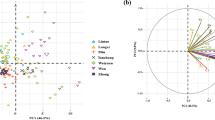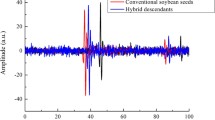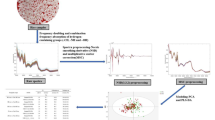Abstract
The measurement of pesticide content in pulses at various stages of the supply chain is important in order to manage the maximum residue level (MRL) set by different government agencies. The objective of this study was to develop a non-destructive detection system to determine the glyphosate content in 6 pulses (chickpea, yellow pea, red lentil, large green lentil, French green lentil, and black beluga lentil) based on Fourier transform infrared spectroscopy (FTIR). Organically grown pulses were artificially spiked with glyphosate at 5 concentrations (0 mg/kg, 5 mg/kg, 10 mg/kg, 15 mg/kg and 20 mg/kg) and used for the development and testing of FTIR spectroscopy and associated chemometric models. Principal component analysis (PCA) led to the discrimination and clustering in the pulse samples based on the applied glyphosate levels. Various preprocessing and variable selection techniques were applied on the spectral dataset and partial least squares (PLS) regression was used to predict the glyphosate levels in pulses. The correlation coefficient for prediction (Rp2) of glyphosate was 0.93, 0.92, 0.96, 0.91, 0.96, and 0.92 for yellow pea, chickpea, large green lentil, red lentil, black beluga, and French green lentil, respectively with optimized preprocessing and variable selection techniques.



















Similar content being viewed by others
References
Barja BC, Herszage J, dos Santos Afonso M (2001) Iron (III)–phosphonate complexes. Polyhedron 20(15–16):1821–1830. https://doi.org/10.1016/S0277-5387(01)00741-0
Benbrook CM (2016) Trends in glyphosate herbicide use in the United States and globally. Environ Sci Europe 28(1):1–15. https://doi.org/10.1186/s12302-016-0070-0
Castillejos-Mijangos LA, Acosta-Caudillo A, Gallardo-Velázquez T, Osorio-Revilla G, Jiménez-Martínez C (2022) Uses of FT-MIR spectroscopy and multivariate analysis in quality control of coffee, cocoa, and commercially important spices. Foods 11(4):579. https://doi.org/10.3390/foods11040579
Cen H, He Y (2007) Theory and application of near infrared reflectance spectroscopy in determination of food quality. Trends Food Sci Technol 18(2):72–83. https://doi.org/10.1016/j.tifs.2006.09.003
Columé A, Diewok J, Lendl B (2004) Assessment of FTIR spectrometry for pesticide screening of aqueous samples. Int J Environ Anal Chem 84(11):835–844. https://doi.org/10.1080/0306731031000149697
da Costa Filho PA (2009) Rapid determination of sucrose in chocolate mass using near infrared spectroscopy. Anal Chim Acta 631(2):206–211. https://doi.org/10.1016/j.aca.2008.10.049
Davis R, Mauer LJ (2010) Fourier transform infrared (FT-IR) spectroscopy: a rapid tool for detection and analysis of foodborne pathogenic bacteria. Current research, technology and education topics in applied microbiology and microbial biotechnology, vol 2, pp 1582–1594. https://www.academia.edu/download/61513069/Davis___Mauer__201020191214-15260-1c3stns.pdf
de Lima ABS, Batista AS, de Jesus JC, de Jesus Silva J, de Araújo ACM, Santos LS (2020) Fast quantitative detection of black pepper and cumin adulterations by near-infrared spectroscopy and multivariate modeling. Food Control 107:106802. https://doi.org/10.1016/j.foodcont.2019.106802
de Santana H, Toni LR, Benetoli LODB, Zaia CT, Rosa M Jr, Zaia DA (2006) Effect in glyphosate adsorption on clays and soils heated and characterization by FT-IR spectroscopy. Geoderma 136(3–4):738–750. https://doi.org/10.1016/j.geoderma.2006.05.012
Dill GM, Sammons RD, Feng PC, Kohn F, Kretzmer K, Mehrsheikh A, Haupfear EA (2010) Glyphosate: discovery, development, applications, and properties. Glyphosate Resist Crops Weeds Hist Dev Manag 1:344. https://doi.org/10.1002/9780470634394.ch1
Duke SO (2018) The history and current status of glyphosate. Pest Manag Sci 74(5):1027–1034. https://doi.org/10.1002/ps.4652
Durak T, Depciuch J (2020) Effect of plant sample preparation and measuring methods on ATR-FTIR spectra results. Environ Exp Bot 169:103915. https://doi.org/10.1016/j.envexpbot.2019.103915
FDA, Food and Drug Administration (2019) Pesticide residue monitoring program fiscal year 2019 pesticide report. https://www.fda.gov/food/chemicals-metals-pesticides-food/pesticides. Accessed 5 Jan 2023
Foucart S, Horel S (2018) Risks associated with glyphosate weedkiller resurface. Nature 555(7697):443–444. https://pubmed.ncbi.nlm.nih.gov/29565384/
Fu W, Guo Q, Wang J (2010) Solubility of glyphosate in ethanol+ water, 1-propanol + water, and 2-propanol + water from (293 to 333) K. J Chem Eng Data 55(9):3915–3917. https://doi.org/10.1021/je901006c
The Western Producer (2022) Glyphosate concerns cause producer pulses to rise. [Internet]. https://www.producer.com/news/glyphosate-concerns-cause-producer-pulses-to-rise/. Accessed 5 Jan 2023
Health Canada (2023) Maximum Residue Limits for Pesticides. https://www.canada.ca/en/health-canada/services/consumer-product-safety/pesticides-pest-management/public/protecting-your-health-environment/pesticides-food/maximum-residue-limits-pesticides.html. Accessed 5 Jan 2023
Habekost A (2015) Spectroscopic and electrochemical investigations of N-(phosphonomethyl) glycine (glyphosate) and (aminomethyl) phosphonic acid (AMPA). J Chem Educ 3:134–140. http://pubs.sciepub.com/wjce/3/6/2
Herath I, Kumarathilaka P, Jayawardhana O, Mayakaduwa S, Bandara T, Wickramasinghe S, Vithanage M (2017) Rice husk derived engineered biochar for glyphosate removal in aqueous media; engineered biochar for pesticides removal. In: Proceedings of the international conference environmental conservation, clean water, air and soil (CleanWAS), Beijing, China, 26–28 August 2016. IWA Publishing, London, UK, p. 164. http://scholar.sjp.ac.lk/meththika/publications/rice-husk-derived-engineered-biochar-glyphosate-removal-aqueous-media-0
Hongyu KUANG, Sandanielo VLM, Oliveira Junior GJD (2015) Principal component analysis: theory, interpretations and applications. Eng Sci 5(1):83–90. https://doi.org/10.18607/ES201653398
Jamshidi B, Mohajerani E, Jamshidi J, Minaei S, Sharifi A (2015) Non-destructive detection of pesticide residues in cucumber using visible/near-infrared spectroscopy. Food Addit Contam Part A 32(6), 857–863. https://pubmed.ncbi.nlm.nih.gov/25789964/
Kanissery R, Gairhe B, Kadyampakeni D, Batuman O, Alferez F (2019) Glyphosate: its environmental persistence and impact on crop health and nutrition. Plants 8(11):499. https://doi.org/10.3390/plants8110499
Kar S, Tudu B, Bag AK, Bandyopadhyay R (2018) Application of near-infrared spectroscopy for the detection of metanil yellow in turmeric powder. Food Anal Methods 11:1291–1302. https://doi.org/10.1007/s12161-017-1106-9
Khodabakhshian R, Bayati MR, Emadi B (2022) Adulteration detection of Sudan Red and metanil yellow in turmeric powder by NIR spectroscopy and chemometrics: the role of preprocessing methods in analysis. Vib Spectrosc 120:103372. https://doi.org/10.1016/j.vibspec.2022.103372
Kolakowski BM, Miller L, Murray A, Leclair A, Bietlot H, van de Riet JM (2020) Analysis of glyphosate residues in foods from the Canadian retail markets between 2015 and 2017. J Agric Food Chem 68(18):5201–5211. https://doi.org/10.1021/acs.jafc.9b07819
Li W, Sun M, Li M (2013) Research article a survey of determination for organophosphorus pesticide residue in agricultural products. Adv J Food Sci Technol 5(4):381–386. https://doi.org/10.19026/ajfst.5.3275
Lu Y, Li X, Li W, Shen T, He Z, Zhang M, Liu F (2021) Detection of chlorpyrifos and carbendazim residues in the cabbage using visible/near-infrared spectroscopy combined with chemometrics. Spectrochim Acta Part A Mol Biomol Spectrosc 257:119759. https://doi.org/10.1016/j.saa.2021.119759
Miano TM, Piccolo A, Celano G, Senesi N (1992) Infrared and fluorescence spectroscopy of glyphosate-humic acid complexes. Sci Total Environ 123:83–92. https://doi.org/10.1016/0048-9697(92)90135-F
Mishra G, Srivastava S, Panda BK, Mishra HN (2018) Sensor array optimization and determination of Rhyzopertha dominica infestation in wheat using hybrid neuro-fuzzy-assisted electronic nose analysis. Anal Methods 10(47):5687–5695. https://doi.org/10.1039/C8AY01921E
Moghimi A, Aghkhani MH, Sazgarnia A, Sarmad M (2010) Vis/NIR spectroscopy and chemometrics for the prediction of soluble solids content and acidity (pH) of kiwifruit. Biosyst Eng 106(3):295–302. https://doi.org/10.1016/j.biosystemseng.2010.04.002
Peng Y, Li Y, Chen J (2012) Optical technologies for determination of pesticide residue. Infrared spectroscopy-materials science, engineering and technology, InTech, 453–466. https://cdn.intechopen.com/pdfs/36189/InTechOptical_technologies_for_determination_of_pesticide_residue.pdf
Portier CJ (2020) A comprehensive analysis of the animal carcinogenicity data for glyphosate from chronic exposure rodent carcinogenicity studies. Environ Health 19(1):1–17. https://doi.org/10.1186/s12940-020-00574-1
Pulse Canada (2023) Pulse Canada [Internet]. https://pulsecanada.com/. Accessed 5 Jan 2023
Sánchez MT, Flores-Rojas K, Guerrero JE, Garrido-Varo A, Pérez-Marín D (2010) Measurement of pesticide residues in peppers by near-infrared reflectance spectroscopy. Pest Manag Sci Former Pestic Sci 66(6):580–586. https://doi.org/10.1002/ps.1910
Saranwong I, Kawano S (2005) Rapid determination of fungicide contaminated on tomato surfaces using the DESIR-NIR: a system for ppm-order concentration. J Near Infrared Spectrosc 13(3), 169–175. https://opg.optica.org/abstract.cfm?uri=jnirs-13-3-169
Shrestha S, Deleuran LC, Gislum R (2017) Separation of viable and non-viable tomato (Solanum lycopersicum L.) seeds using single seed near-infrared spectroscopy. Comput Electron Agric 142:348–355. https://doi.org/10.1016/j.compag.2017.09.004
Sindhu S, Manickavasagan A (2023) Nondestructive testing methods for pesticide residue in food commodities: a review. Compr Rev Food Sci Food Saf 22(2):1226–1256. https://doi.org/10.1111/1541-4337.13109
Sindhu S, Manickavasagan A, Ali A (2023) (2023) Effect of soaking conditions on glyphosate absorption in selected pulses understanding solvent behaviour and morphological changes. Int J Environ Anal Chem. https://doi.org/10.1080/03067319.2023.2187699
Stöbener A, Naefken U, Kleber J, Liese A (2019) Determination of trace amounts with ATR FTIR spectroscopy and chemometrics: 5-(hydroxymethyl) furfural in honey. Talanta 204:1–5. https://doi.org/10.1016/j.talanta.2019.05.092
Sun X, Li H, Yi Y, Hua H, Guan Y, Chen C (2021) Rapid detection and quantification of adulteration in Chinese hawthorn fruits powder by near-infrared spectroscopy combined with chemometrics. Spectrochim Acta Part A Mol Biomol Spectrosc 250:119346. https://doi.org/10.1016/j.saa.2020.119346
Tao Y, Dong F, Xu J, Liu X, Cheng Y, Liu N, Zheng Y (2014) Green and sensitive supercritical fluid chromatographic–tandem mass spectrometric method for the separation and determination of flutriafol enantiomers in vegetables, fruits, and soil. J Agric Food Chem 62(47):11457–11464. https://doi.org/10.1021/jf504324t
Tsagkaris AS, Bechynska K, Ntakoulas DD, Pasias IN, Weller P, Proestos C, Hajslova J (2023) Investigating the impact of spectral data pre-processing to assess honey botanical origin through Fourier transform infrared spectroscopy (FTIR). J Food Compos Anal 119:105276. https://doi.org/10.1016/j.jfca.2023.105276
Wang J, Liu H, Ren G (2014) Near-infrared spectroscopy (NIRS) evaluation and regional analysis of Chinese faba bean (Vicia faba L.). Crop J 2(1):28–37. https://doi.org/10.1016/j.cj.2013.10.001
Wang Z, Wu Q, Kamruzzaman M (2022) Portable NIR spectroscopy and PLS based variable selection for adulteration detection in quinoa flour. Food Control 138:108970. https://doi.org/10.1016/j.foodcont.2022.108970
Watts M, Clausing P, Lyssimachou A, Schutte G, Guadagnini R, Marquez E (2016) Glyphosate monograph. https://pan-international.org/wp-content/uploads/Glyphosate-monograph.pdf
Wu H, Yue T, Xu Z, Zhang C (2017) Sensor array optimization and discrimination of apple juices according to variety by an electronic nose. Anal Methods 9(6):921–928. https://doi.org/10.1039/C6AY02610A
Xiao G, Dong D, Liao T, Li Y, Zheng L, Zhang D, Zhao C (2015) Detection of pesticide (chlorpyrifos) residues on fruit peels through spectra of volatiles by FTIR. Food Anal Methods 8:1341–1346. https://doi.org/10.1007/s12161-014-0015-4
Yu HD, Zuo SM, Xia G, Liu X, Yun YH, Zhang C (2020) Rapid and nondestructive freshness determination of tilapia fillets by a portable near-infrared spectrometer combined with chemometrics methods. Food Anal Methods 13:1918–1928. https://doi.org/10.1007/s12161-020-01816-1
Zhang H, Hu X, Liu L, Wei J, Bian X (2022) Near infrared spectroscopy combined with chemometrics for quantitative analysis of corn oil in edible blend oil. Spectrochim Acta Part A Mol Biomol Spectrosc 270:120841. https://doi.org/10.1016/j.saa.2021.120841
Acknowledgements
This research was supported by the Natural Sciences and Engineering Research Council of Canada (NSERC) (401501) and Barrett Sustainable Food Engineering Grant, University of Guelph.
Author information
Authors and Affiliations
Contributions
SS: conceptualization, data curation, formal analysis, investigation, methodology, experimentation, writing—original draft. SS: data analysis, experimentation, writing—review and editing. AM: funding acquisition, conceptualization, writing—review and editing.
Corresponding author
Ethics declarations
Conflict of interest
The authors declare that there is no conflict of interest in this paper.
Additional information
Publisher's Note
Springer Nature remains neutral with regard to jurisdictional claims in published maps and institutional affiliations.
Supplementary Information
Below is the link to the electronic supplementary material.
Rights and permissions
Springer Nature or its licensor (e.g. a society or other partner) holds exclusive rights to this article under a publishing agreement with the author(s) or other rightsholder(s); author self-archiving of the accepted manuscript version of this article is solely governed by the terms of such publishing agreement and applicable law.
About this article
Cite this article
Sindhu, S., Sharma, S. & Manickavasagan, A. Evaluating chemometric techniques for non-destructive detection of glyphosate residues in single pulse grains by using FTIR spectroscopy. J Consum Prot Food Saf 18, 309–326 (2023). https://doi.org/10.1007/s00003-023-01447-8
Received:
Revised:
Accepted:
Published:
Issue Date:
DOI: https://doi.org/10.1007/s00003-023-01447-8




